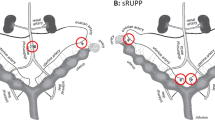Abstract
Objective
To determine whether a rat model of preeclampsia includes features consistent with HELLP (hemolysis, elevated liver enzymes, low platelets) syndrome.
Methods
Preeclampsia was induced experimentally in timed-pregnant Sprague-Dawley rats using the reduced uterine perfusion pressure (RUPP) model. On day 14 of gestation, silver clips were placed around the aorta below the renal arteries and on the left and right uterine arcade at the ovarian artery. All animals were chronically instrumented to determine conscious blood pressure and to obtain blood samples for analysis of complete blood count, platelet count, liver function tests, uric acid, creatinine, and albumin. Blood samples were collected and animals sacrificed on day 19 of gestation, at which time placental and pup weight were obtained. A control group was analyzed similarly. Statistical analysis was performed with the Student t test.
Results
The RUPP model animals (n = 8), when compared with the normotensive controls (n = 9), did not show a statistically significant different in hemoglobin, platelets, liver function tests, uric acid, creatinine, or albumin, although the mean arterial pressure was higher (mean ± SD 131.9 ± 17.1 mmHg versus 104.0 ± 14.0 mmHg, respectively; P = 0.003) and pup number was lower (RUPP 6.6 ± 2.4 versus control 13.8 ± 2.3, P < .001).
Conclusion
Although decreased uteroplacental perfusion induces changes similar to symptoms of preeclampsia, the RUPP rat model does not appear to express features of HELLP syndrome.
Similar content being viewed by others
References
Roberts JM, Cooper DW. Pathogenesis and genetics of preeclampsia. Lancet 2001;357:53–56.
Dekker GA, Sibai BM. Etiology and pathogenesis of preeclampsia: Current concepts. Am J Obstet Gynecol 1998;179:1359–1375.
Alexander BT, Kassab SE, Miller MT, et al. Reduced uterine perfusion pressure during pregnancy in the rat is associated with increases in arterial pressure and changes in renal nitric oxide. Hypertension 2001;37:1191–1195.
Faas MM, Schuiling GA, Baller JF, Visscher CA, Bakker WW. A new animal model for human preeclampsia: Ultra-low-dose endotoxin infusion in pregnant rat. Am J Obstet Gynecol 1994;171:158–164.
Alexander BT, Cockrell KL, Massey MB, Bennett WA, Granger JP. Tumor necrosis factor-alpha-induced hypertension in pregnant rats results in decreased renal neuronal nitric oxide synthase expression. Am J Hypertens 2002;15:170–175.
Granger JP, Alexander BT, Llinas MT, Bennett WA, Khalil RA. Pathophysiology of preeclampsia: Linking placental ischemia/hypoxia with microvascular dysfunction. Microcirculation 2002;9:147–160.
Magann EF, Bass D, Chauhan SP, Sullivan DL, Martin RW, Martin JN Jr. Antepartum corticosteroids: Disease stabilization in patients with the syndrome of hemolysis, elevated liver enzymes, and low platelets (HELLP). Am J Obstet Gynecol 1994;171:1148–1153.
Robertson WB, Brosens I, Dixon HG. The pathological response of the vessels of the placental bed to hypertensive pregnancy. J Pathol Bacteriol 1967;93:581–592.
Brosens IA, Robertson WB, Dixon HG. The role of the spiral arteries in the pathogenesis of preeclampsia. Obstet Gynecol Annu 1972;1:177–191.
Roberts JM, Taylor RN, Musci TJ, et al. Preeclampsia: An endothelial cell disorder. Am J Obstet Gynecol 1989;161:1200–1204.
Roberts JM. Objective evidence of endothelial dysfunction in preeclampsia. Am J Kidney Dis 1999;33:992–997.
Zeeman GG, Dekker GA, van Geijn HP, Krrayenbrink AA. Endothelial function in normal and pre-eclamptic pregnancies: A hypothesis. Eur J Obstet Gynecol Reprod Biol 1992;43:113–122.
Bussen S, Sutterlin M, Streck T. Plasma endothelin and big endothelian levels in women with severe preeclampsia or HELLP-syndrome. Arch Gynecol Obstet 1999;262:113–119.
Terrone DA, Rinehart BK, May WL, Moore A, Magann EF, Martin JN Jr. Leukocytosis is proportional to HELLP syndrome severity: Evidence for an inflammatory form for preeclampsia. South Med J 2000;93:768–771.
Haeger M, Unander M, Andersson B, Tarkowski A, Arnestad JP, Bengtsson A. Increased release of tumor necrosis factor-alpha and interleukin-6 in women with the syndrome of hemolysis, elevated liver enzymes and low platelet count. Acta Obstet Gynecol Scand 1996;75:695–701.
Visser W, Beckimann I, Bremer HA, Lim HL, Wallenburg HC. Bioactive tumor necrosis factor alpha in pre-eclamptic patients with and without the HELLP syndrome. Br J Obstet Gynaecol 1994;101:1081–1082.
Author information
Authors and Affiliations
Corresponding author
Additional information
Supported in part by the Vicksburg Medical Froundation, Vicksburg, Mississippi.
Rights and permissions
About this article
Cite this article
Isler, C.M., Bennett, W.A., Rinewalt, A.N. et al. Evaluation of a Rat Model of Preeclampsia for HELLP Syndrome Characteristics. Reprod. Sci. 10, 151–153 (2003). https://doi.org/10.1016/S1071-5576(03)00009-1
Published:
Issue Date:
DOI: https://doi.org/10.1016/S1071-5576(03)00009-1




